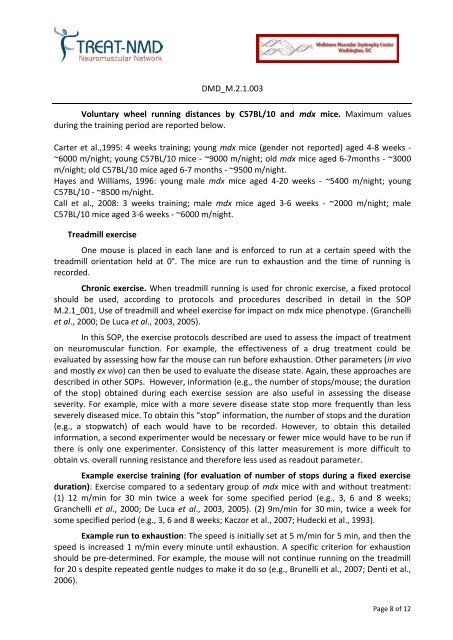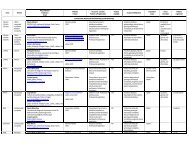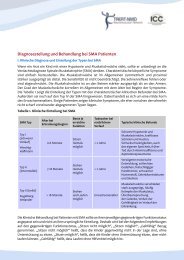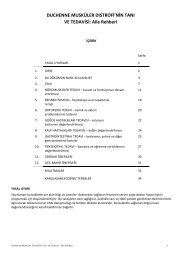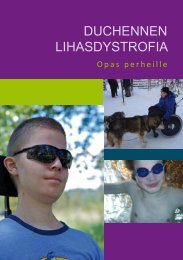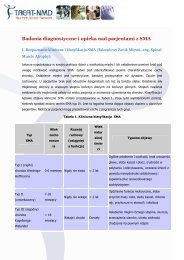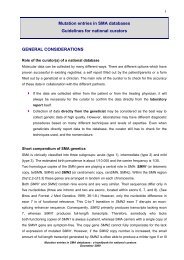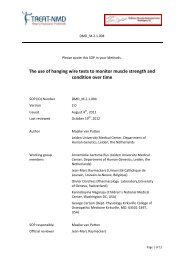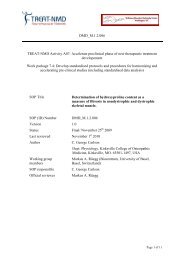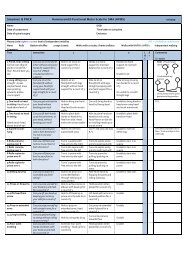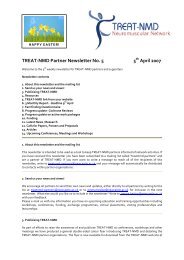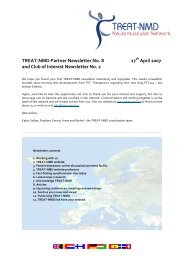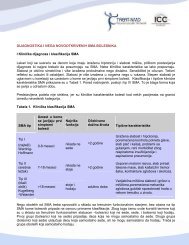Use of treadmill and wheel exercise to assess ... - Treat-NMD
Use of treadmill and wheel exercise to assess ... - Treat-NMD
Use of treadmill and wheel exercise to assess ... - Treat-NMD
Create successful ePaper yourself
Turn your PDF publications into a flip-book with our unique Google optimized e-Paper software.
DMD_M.2.1.003<br />
Voluntary <strong>wheel</strong> running distances by C57BL/10 <strong>and</strong> mdx mice. Maximum values<br />
during the training period are reported below.<br />
Carter et al.,1995: 4 weeks training; young mdx mice (gender not reported) aged 4-8 weeks -<br />
~6000 m/night; young C57BL/10 mice - ~9000 m/night; old mdx mice aged 6-7months - ~3000<br />
m/night; old C57BL/10 mice aged 6-7 months - ~9500 m/night.<br />
Hayes <strong>and</strong> Williams, 1996: young male mdx mice aged 4-20 weeks - ~5400 m/night; young<br />
C57BL/10 - ~8500 m/night.<br />
Call et al., 2008: 3 weeks training; male mdx mice aged 3-6 weeks - ~2000 m/night; male<br />
C57BL/10 mice aged 3-6 weeks - ~6000 m/night.<br />
Treadmill <strong>exercise</strong><br />
One mouse is placed in each lane <strong>and</strong> is enforced <strong>to</strong> run at a certain speed with the<br />
<strong>treadmill</strong> orientation held at 0°. The mice are run <strong>to</strong> exhaustion <strong>and</strong> the time <strong>of</strong> running is<br />
recorded.<br />
Chronic <strong>exercise</strong>. When <strong>treadmill</strong> running is used for chronic <strong>exercise</strong>, a fixed pro<strong>to</strong>col<br />
should be used, according <strong>to</strong> pro<strong>to</strong>cols <strong>and</strong> procedures described in detail in the SOP<br />
M.2.1_001, <strong>Use</strong> <strong>of</strong> <strong>treadmill</strong> <strong>and</strong> <strong>wheel</strong> <strong>exercise</strong> for impact on mdx mice phenotype. (Granchelli<br />
et al., 2000; De Luca et al., 2003, 2005).<br />
In this SOP, the <strong>exercise</strong> pro<strong>to</strong>cols described are used <strong>to</strong> <strong>assess</strong> the impact <strong>of</strong> treatment<br />
on neuromuscular function. For example, the effectiveness <strong>of</strong> a drug treatment could be<br />
evaluated by <strong>assess</strong>ing how far the mouse can run before exhaustion. Other parameters (in vivo<br />
<strong>and</strong> mostly ex vivo) can then be used <strong>to</strong> evaluate the disease state. Again, these approaches are<br />
described in other SOPs. However, information (e.g., the number <strong>of</strong> s<strong>to</strong>ps/mouse; the duration<br />
<strong>of</strong> the s<strong>to</strong>p) obtained during each <strong>exercise</strong> session are also useful in <strong>assess</strong>ing the disease<br />
severity. For example, mice with a more severe disease state s<strong>to</strong>p more frequently than less<br />
severely diseased mice. To obtain this “s<strong>to</strong>p” information, the number <strong>of</strong> s<strong>to</strong>ps <strong>and</strong> the duration<br />
(e.g., a s<strong>to</strong>pwatch) <strong>of</strong> each would have <strong>to</strong> be recorded. However, <strong>to</strong> obtain this detailed<br />
information, a second experimenter would be necessary or fewer mice would have <strong>to</strong> be run if<br />
there is only one experimenter. Consistency <strong>of</strong> this latter measurement is more difficult <strong>to</strong><br />
obtain vs. overall running resistance <strong>and</strong> therefore less used as readout parameter.<br />
Example <strong>exercise</strong> training (for evaluation <strong>of</strong> number <strong>of</strong> s<strong>to</strong>ps during a fixed <strong>exercise</strong><br />
duration): Exercise compared <strong>to</strong> a sedentary group <strong>of</strong> mdx mice with <strong>and</strong> without treatment:<br />
(1) 12 m/min for 30 min twice a week for some specified period (e.g., 3, 6 <strong>and</strong> 8 weeks;<br />
Granchelli et al., 2000; De Luca et al., 2003, 2005). (2) 9m/min for 30 min, twice a week for<br />
some specified period (e.g., 3, 6 <strong>and</strong> 8 weeks; Kaczor et al., 2007; Hudecki et al., 1993).<br />
Example run <strong>to</strong> exhaustion: The speed is initially set at 5 m/min for 5 min, <strong>and</strong> then the<br />
speed is increased 1 m/min every minute until exhaustion. A specific criterion for exhaustion<br />
should be pre-determined. For example, the mouse will not continue running on the <strong>treadmill</strong><br />
for 20 s despite repeated gentle nudges <strong>to</strong> make it do so (e.g., Brunelli et al., 2007; Denti et al.,<br />
2006).<br />
Page 8 <strong>of</strong> 12


